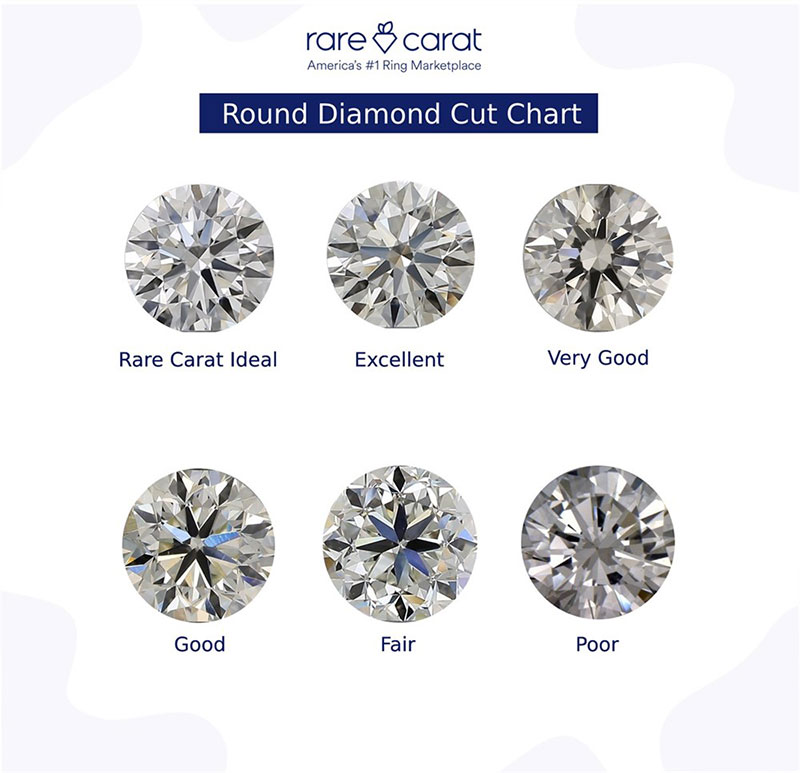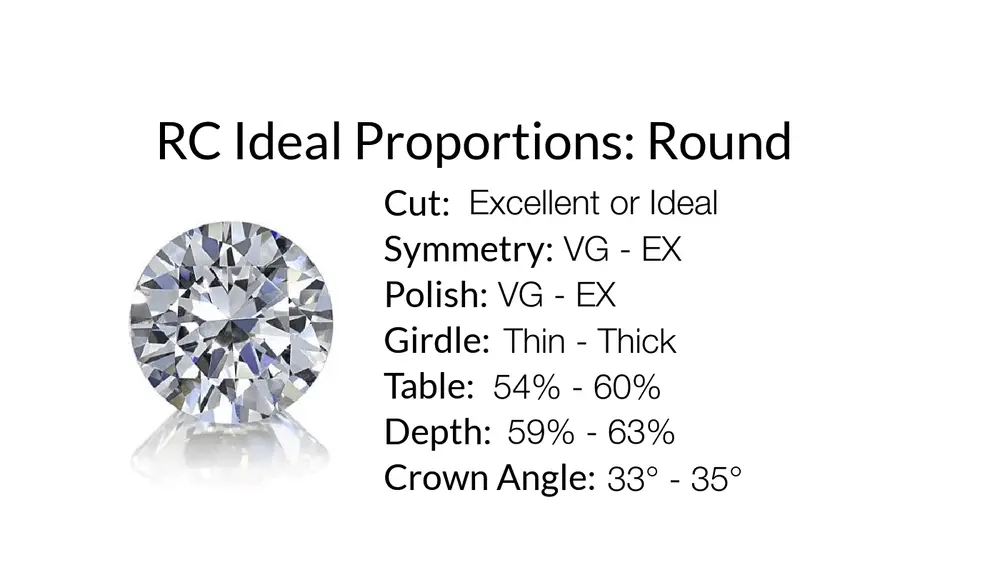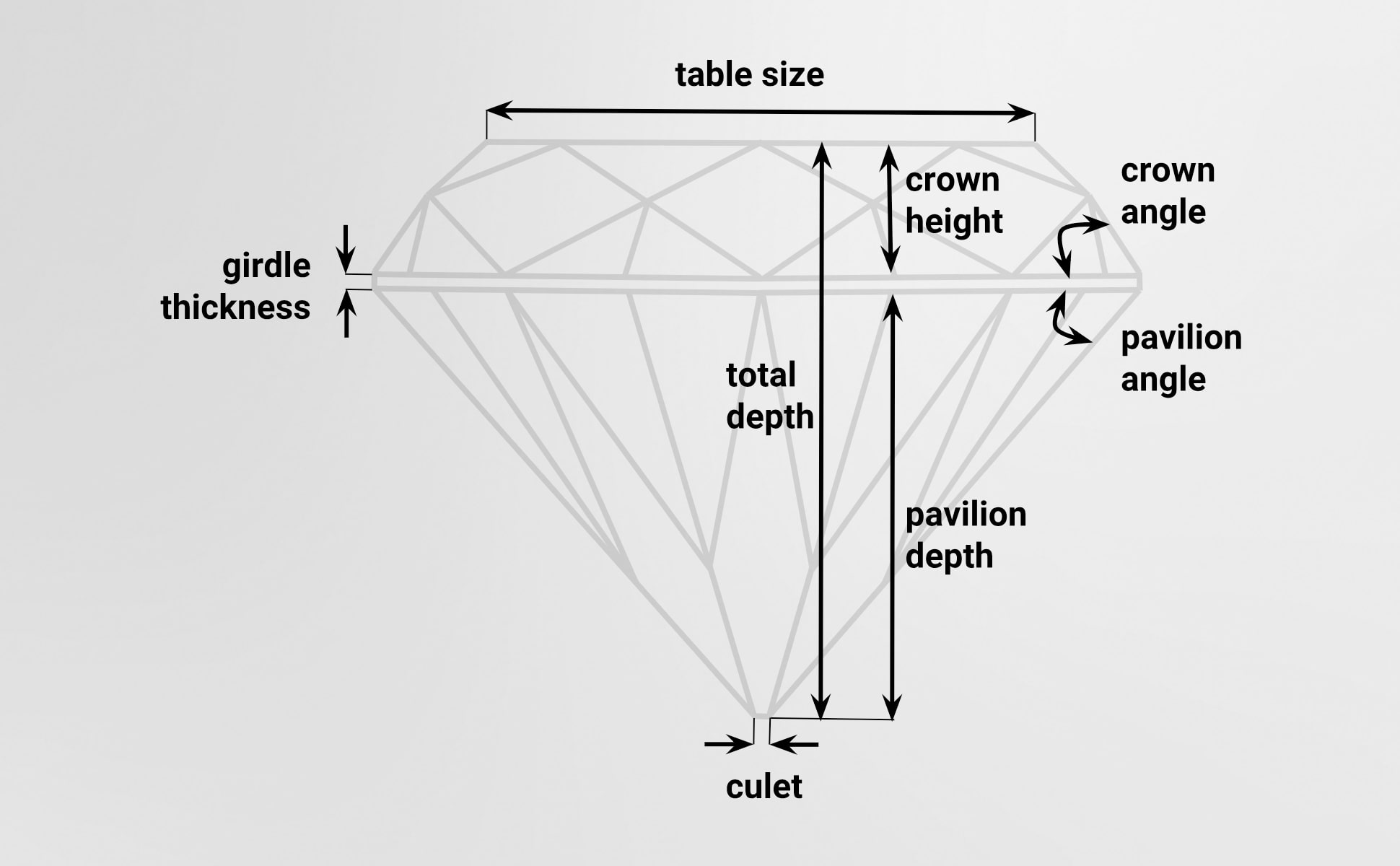Fast Facts on Diamond Cut
- Diamond Cut grade represents the quality of how well a diamond is fashioned. Well-cut diamonds have an optimal light return, adding to their sparkle.
- Diamond shapes are sometimes referred to as 'cut styles', but here we're talking purely about a diamond's cut grade.
- When a diamond is cut well, not only does it affect the overall beauty but also the price.
- The ideal depth for an ‘excellent’ cut round brilliant diamond is somewhere between 59% - 63%.
- The ideal table size for an ‘excellent’ cut round brilliant diamond is somewhere between 54% - 60%.
- You can check the cut and proportions for your diamond by putting it into our free report service
What is the Cut Grade of a Diamond?
Often confused with the shape of the diamond round, princess, pear, etc.), the cut actually refers to the way the facets interact with light. A lot of time, knowledge and skill goes into fashioning a diamond so that its proportions, polish and symmetry all interact in just the right way to provide amazing sparkle and shine.

Currently, the only shape diamond that receives an official cut grade from the GIA and IGI (for lab grown diamonds) is the round brilliant. For the fancy shapes, anything that is not round, we look at the polish, symmetry and proportions to determine how well it has been cut and how much sparkle and shine it will have (see below for more details).
What are the Different Cut Grades?
The cut grade incorporates the overall faceup appearance, design and craftsmanship of the diamond. This is where all of the sparkle and shine comes from so it's important to have the highest grade and it should take precedence over color, clarity and carat.
All of the natural diamonds listed here at Rare Carat have been graded by the GIA and come with a grading report and matching laser inscription on the girdle. When you look at the report, the first thing you want to check is the cut grade. For GIA graded diamonds, we want to see Excellent and for IGI graded stones, Ideal.
GIA Cut Grades Defined
- Excellent: very bright, with an even pattern of contrasting dark and light areas. The facets are crisp and well-aligned.
- Very Good: not as bright, some of the facets may be slightly misaligned.
- Good: more darkness, can appear dull and have darker areas.
- Fair: poorly shaped facets that aren't aligned well, dark and dull
- Poor: very prominent dark areas, much less sparkle, very little shine
*IGI's grading system is the same as GIA but with the addition of the Ideal cut grade (equal to GIA Excellent).
Rare Carat Offers 4 Cut Grades
Here at Rare Carat, we do not list Fair or Poor cut diamonds. Even though they are often much less expensive, they are inferior to a well-cut stone. We want to ensure that you not only get a great deal on your diamond but also get one that is beautiful, that's why we only list Rare Carat Ideal, Excellent, Very Good and Good (and Ideal for lab grown diamonds).

What is Rare Carat Ideal?
Rare Carat Ideal is not actually a cut grade, but a filter that we have set up to ensure you get a well-cut diamond. It sets the ideal standards for any shape diamond based on the recommended cut grade, polish, symmetry and proportions. Below are the recommended ideals for a round brilliant, to see the other shapes check out our shapes guide.

What are the Characteristics of a Well-Cut Diamond?

The easy answer...a ton of sparkle, shine and brightness. The scientific answer... brilliance, fire and scintillation!
- Brilliance: otherwise known as brightness, is the effect of all the diamond's internal and external reflections of white light. The brighter the diamond, the higher the grade will be.
- Fire: this is the spectral colors that we see from a diamond. All of the flashes of colored light when the diamond is rocked back and forth under a direct light source.
- Scintillation: a combination of sparkle and light pattern. Sparkle is the spots of light that flash when the diamond, you or the light source move. Pattern is the contrast between the light and dark areas within the diamond.
The Anatomy and Proportions of a Diamond
The proportions of a diamond all work together to ensure the angles and measurements all match up to give the most brilliance, fire and scintillation possible.
- Table: This is the largest facet on a diamond. It's where a majority of the light enters and exits bringing sparkle to the eye.
- Girdle: This is the separation plane between the crown (top) and pavilion (bottom) of the diamond. It is used to measure the diameter of the diamond in millimeters.
- Crown: This is the top portion of the diamond extending from the girdle to the table.
- Pavilion: This is the bottom portion of the diamond extending from the girdle to the culet (or point).
- Culet: This is the facet at the bottom of the diamond. Not all diamonds have a culet - if it does not, it will come to a point.

- Table Percentage: The table percentage tells us how big the 'face' of the diamond is in comparison to the diameter. Too large, and it will leak light out the sides and bottom causing it to lose sparkle. Too small and it won't take in enough light causing it to look dark.

- Depth Percentage: The depth percentage tells us how deep or shallow the diamond is cut. Too deep and there will be wasted carat weight sitting in the bottom that can't be seen in a setting. Too shallow and the stone will look larger up top, but will leak light due to improper angles.

- Girdle Thickness: This tells us how thick or thin the girdle is. Too thin (extremely thin and sometimes very thin) and the diamond becomes susceptible to chipping. Too thick (extremely thick and sometimes very) and the diamond carries wasted carat weight along the middle and it becomes hard to keep it secure in the setting.

- Crown Angle (for round diamonds only): This tells us how steep or flat the crown (top portion) of the diamond is. Too steep and you get a lot of fire, but a dark stone and it looks like a snow cone. Too flat and you get more brightness, but less sparkle and it looks like a flat plateau.

Diamond Symmetry
The symmetry of a diamond is the "exactness of a diamond's outline, and the shape, placement and alignment of its facets". The better the facets are fashioned, the more the diamond is going to sparkle and shine! One little error could spell disaster for how a diamond performs and looks. We like to see Very Good to Excellent here for every diamond shape.
Diamond Polish
The polish of a diamond is the measure of how smooth the surface of the diamond is. We like to see Very Good to Excellent for all shapes here as well. Anything lower and you will start seeing surface blemishes including burn marks and polish lines.
Natural vs. Lab Grown - Are They Graded Differently for Cut?
Lab-grown diamonds go through the same rigorous grading process for cut as natural diamonds do. To learn more about lab grown diamonds and their difference from natural, check out this comprehensive lab-diamond article.
Learn More About the 4Cs
Now that you are a cut grade master, you can learn more about the other C's below! As always, if you ever have any diamond questions feel free to reach out to one of our many graduate gemologists via chat.

